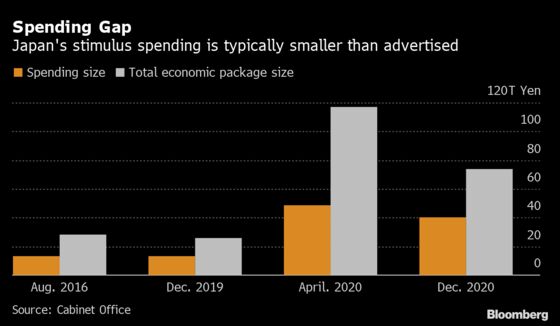Japan’s Stimulus Likely to Reveal Kishida’s True Spending Colors
(Bloomberg) -- Prime Minister Fumio Kishida’s stronger-than-expected election victory smooths the path for a stimulus package that signals whether he’s a big spender or a budget balancer.
The package is expected to be unveiled before the end of the month and is likely to include cash handouts and a re-launching of domestic travel subsidies. Kishida has yet to put a figure on the spending, but has said it will be worth trillions of yen.
The tricky part will be unraveling how much new money will actually be set aside to fund the spending, the key signal for how aggressive Kishida really is on fiscal support for the economy.

With a stack of unused budget funds still left over from the first year of the pandemic, the prime minister could yet launch a big ticket package without spending any new money at all.
“This was a sweeping victory” for Kishida’s ruling Liberal Democratic Party, Chotaro Morita, chief rates strategist at SMBC Nikko Securities, wrote in a report Monday, suggesting the premier may be more frugal than his predecessors. “Now the chances are high that the economic package won’t be dramatic pork-barrel spending but will reflect Kishida’s thinking more.”
Cash handouts are likely to be the centerpiece of the measures.
Komeito, the LDP’s coalition partner, pledged in the election campaign to give 100,000 yen ($875) for each household member aged 18 or below. Kishida has said he is also in favor of cash handouts without saying who should receive them.
Other likely economic measures include the resumption of the government’s travel discount campaign and funding support for small companies, according to Goldman Sachs economist Naohiko Baba.
Getting the measures right is a key concern for Kishida to ensure voters stay on his side before another election next summer. Kishida needs to win that poll too to shore up his administration for the longer term.
The consensus among economists surveyed by Bloomberg before Sunday’s vote was for measures worth around 30 trillion yen ($263 billion), and more if Kishida fared badly. That amount is equivalent to more than 5% of the economy’s size.
The actual fresh spending Kishida calls upon could be far smaller because of the unused stimulus of about 30.8 trillion yen. In the past the ruling party has used leftover funds to help inflate the size of economic measures, though that’s no guarantee Kishida will do the same.
What Bloomberg Economics Says...
“We expect Kishida to compile an extra budget worth 12 trillion yen to fund a package with a headline figure in line with his pre-election pledge of tens of trillion of yen.”
-- Yuki Masujima, economist
For the full report, click here
Still, if he does include the money, he could roll out stimulus steps without having to issue any new bonds -- typically the measure by which economists assess the punching power of a package.
That approach would make sense if Kishida is looking to keep a lid on actual outlays given Japan’s huge debt pile. The International Monetary Fund forecast Japan’s ratio of public debt to its economy will reach 256.9% this year, the highest among developed economies.
Conversely, Kishida could choose to issue more bonds if he wants to show his aggressiveness on spending.
“We would not expect this fiscal package to be a game changer for next year’s growth,” Masamichi Adachi and Go Kurihara, economists at UBS Securities, wrote in a report. “However, if Kishida can succeed in delivering what the public wishes, that could increase the chance of victory in the upper house election in July next year.”
©2021 Bloomberg L.P.